Silencing Spring
Air Date: Week of September 27, 2019
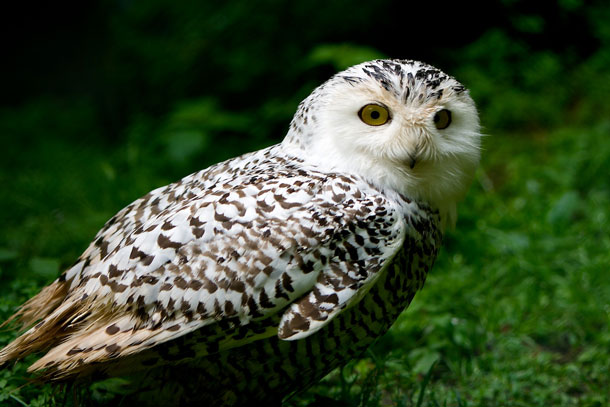
The population of snowy owls has declined 64 percent since 1970, according to the 2019 Science Magazine study. (Photo: Rainer Hungershausen, Flickr, CC BY-NC-ND 2.0)
Birds in North America have declined by as many as 3 billion since the 1970s, according a new study reported in the journal Science. The researchers note many grassland and shorebirds have been hit especially hard with more than 50 percent losses. Host Steve Curwood spoke with Arvind Panjabi, Avian Scientist at the Conservancy of the Rockies and co-author in the study.
Transcript
CURWOOD: From the Jennifer and Ted Stanley Studios at the University of Massachusetts Boston, this is Living on Earth. I’m Steve Curwood.
For proof that the planet is suffering what some call mass extinction number six, you’d need look no further than the birds of North America. Overall the population of birds in the US and Canada has plummeted over the past fifty years by nearly 3 billion, a loss of some 30 percent. Even among more common birds the losses are steep, according to a study published in Science, and conservationists are calling it a crisis. It’s even worse for some. The little yellow and brown Cape May Warblers have declined some seventy percent since 1967.
[SFX CAPE MAY WARBLER (SONG MAY 1, 1982)]
CURWOOD: And at the same time Snowy owls are also down 64 percent.
[SFX SNOWY OWL SOUND]
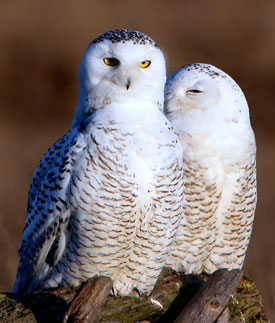
A pair of snowy owls. (Photo: Nigele, Flickr, CC By 2.0)
CURWOOD: The study recently published in Science does not link the avian losses to certain causes, but climate disruption, industrial farming, coastal development and the sharp decline in insects are undoubtedly factors. Arvind Panjabi an Avian conservation scientist at the Bird Conservancy of the Rockies and co-author of the study joins us now. Welcome!
PANJABI: Thank you. It's a pleasure to be here.
CURWOOD: Talk to me about some of the birds that are disappearing that you found in your study. Which ones might be fairly familiar to people, and which ones are, well, not so familiar?
PANJABI: You know, one thing that surprised us was that one of the groups of birds that has declined the most are birds that were introduced into North America well over a century ago. The most common birds that people see in our cities and towns, and also in our farmlands, these are the house sparrow, the European starling and the rock pigeon. They're the ones that we generally tend to think of as being most resilient. And now those three species alone make up nearly 800 million birds that we've lost. And I think there's a number of reasons for that. Our agricultural systems have intensified over the last 50 years, using increasing pesticides and herbicides in order to support large monocultures. So we're losing landscape diversity, we’re losing plant species and insect life within these areas, and that is being reflected in the bird populations.
CURWOOD: What about the snowy owls?
PANJABI: Yeah, snowy owls are an interesting bird that we're just learning more about. And most of the snowy owls are shared across the globe, meaning that their populations may be concentrated in Canada and Alaska in one year, and then be over in Russia and Scandinavia in another year. So, the estimate of snowy owls is only around 15,000 pairs globally. Of course, this is a species that depends on abundant small mammal populations, which are tied to climate, so a lot of vulnerability for the species due to climate change.
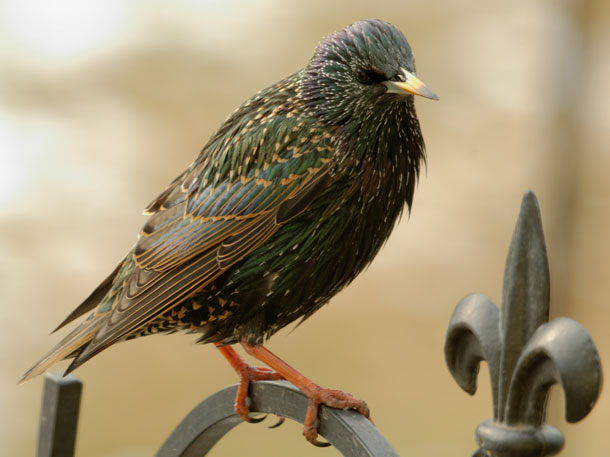
European Starlings are considered a resilient invasive bird, yet they are also in decline. (Photo: Ellen & Tony, Flickr, CC BY-NC-ND 2.0)
CURWOOD: Now, your study is saying that species along grasslands, black finches, sparrows, those are the ones that are declining the most with the loss of almost a billion birds there alone. Why are those birds so vulnerable? What's going on? Why is this happening?
PANJABI: Grasslands of course, have been the center for cropland, agriculture development, and expansion since Europeans arrived in North America. And that trend has been continuing right up through today. There's also been a lot of changes in the structure and composition of grasslands over time, especially in the southern part of our Great Plains that extends down into Mexico and the Chihuahuan desert, which are the primary wintering grounds for the birds from the Northern Great Plains. Those grasslands have shrunk considerably over the last century and a half due to encroachment of the surrounding desert, largely as a result of long term overgrazing that has resulted in a loss of fine fuels and therefore a loss of fire that could help control the encroachment of shrubs.
CURWOOD: Now, what about the shoreline losses?
PANJABI: So shoreline losses are affecting a number of bird species both in our coastal marshes and in the mud flats and beaches. Now, there's been considerable development along our coastlines, of course, these are places that humans love to live and recreate. And these birds that use them; so we have two main groups of birds we have Marsh birds, birds like the black rail, which has just plummeted, virtually disappeared from the eastern United States, the marshes there. And other birds like the salt marsh Sparrow, which is perhaps sadly, going to be the next bird that goes extinct in this country, because its populations are plummeting so fast. And with sea level rise, and higher high tides, the birds get flooded out of their nests.
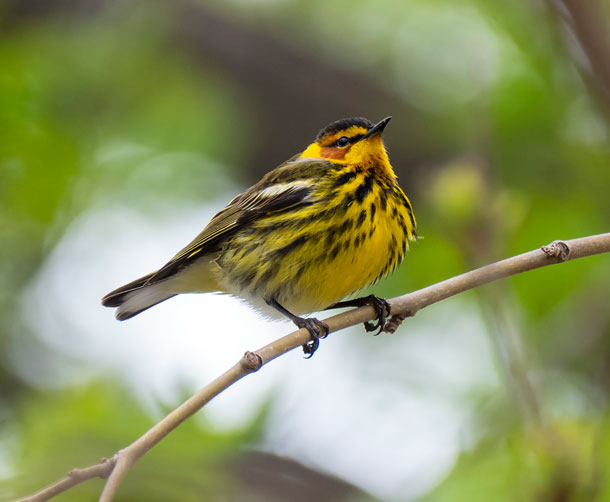
Cape May Warblers are North American birds that winter in the Caribbean. (Photo: Doug Greenberg, Flickr, CC BY-NC 2.0)
CURWOOD: By the way, your report points out that wetland birds are actually on the rise in the U.S. Seems to be the only kinds of birds that are on the rise. Why is that?
PANJABI: That's a good observation. You know, historically, we've lost a lot of wetlands here in North America, and in 1972 we passed the Clean Water Act, which protected wetlands. And our wetland birds have begun to recover. We also banned DDT, which was affecting birds at their reproductive capabilities. Plus, in the 1980s, we passed the North American Wetlands Conservation Act, which provided upwards of $90 million a year to support wetlands protection across North America, from Canada to Mexico and the Caribbean. So we've invested in wetlands conservation, and we've got laws on the books to protect wetlands. Unfortunately, many of those laws are being undone now. And sadly, places like the prairie potholes are now being drained despite having received decades of protection from the Clean Water Act.
CURWOOD: And what birds are dependent on the prairie potholes?

Salt Marsh Sparrows are in extreme decline due to sea level rise. (Photo: Fishhawk, Flickr, CC BY 2.0)
PANJABI: Well, our waterfowl populations, precisely those that have been doing so well over the last few decades. So we're at risk of losing what we've recovered now, because of the change in the interpretation of the Clean Water Act that no longer protects those isolated wetlands.
CURWOOD: To what extent do you think that groups like Ducks Unlimited, those who would hunt waterfowl, have made the difference? Because you say waterfowl are actually going up in this country.
PANJABI: Right. Well, they've actually made a difference. Those federal dollars from the North American Wetlands Conservation Act, those need to be matched one to one with non-federal dollars. So, groups like Ducks Unlimited have been very successful at raising money to match those federal dollars and protect wetlands. And those benefit not just ducks, but other wetland-dependent birds and animals as well.
CURWOOD: Even though some would say ‘but they want to kill ducks’.
PANJABI: Yes, but they do it on a sustainable basis. So, the hunting of ducks clearly has not contributed to the decline of ducks. In fact, it's the opposite. It's generated revenue that has allowed conservation to move forward rapidly, much more so than for non-game species.
CURWOOD: What about global policy to address this loss? If we keep losing 3 billion birds every generation or so, we're going to be, well, out of birds.
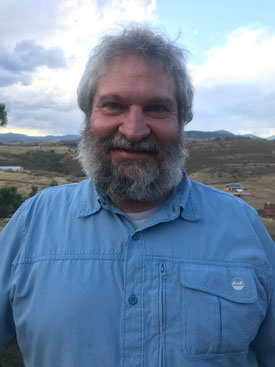
Study co-author Arvind Panjabi is the Avian Scientist at Bird Conservancy of the Rockies. (Photo: Arvind Panjabi, Bird Conservancy of the Rockies)
PANJABI: That's right. These birds cross international boundaries and so we need to work with governments from other countries to ensure their protection. We very badly need the cooperation of the Mexican government to help protect the very limited grasslands that are on the wintering grounds for these birds in Northern Mexico.
CURWOOD: Arvind, what gives you hope in this?
PANJABI: Well, that is a very depressing study, but there's actually great hope. We've been here before, believe it or not. Around 1970, when we banned DDT, we had identified a specific problem with the effects of DDT, impacting the eggs of raptors in particular, such as the bald eagle, the peregrine falcon the osprey, and when we banned that pesticide, those populations recovered. So, today we find ourselves at a much more challenging crossroads, because we've identified declines in so many groups of birds. The solutions are no doubt more complex. Yet, there's been a lot of good work done at identifying the needs for each of these declining bird species. So right now there is an act that's been introduced into Congress. It's called the Restore America's Wildlife Act and what it would do is direct 1.2 billion in offshore oil revenues towards the states to implement these state wildlife action plans. So that would provide a real boost in the arm for state agencies trying to address the needs of hundreds of species for which they previously have not had any funding to do so.
CURWOOD: Arvind Panjabi is a conservation scientist at the Bird Conservancy of the Rockies. Thanks for taking this time with me today.
PANJABI: Thank you, Steve it's a pleasure to be with you.
Links
Science Mag | “Three Billion North American Birds Have Vanished Since 1970, Surveys Show”
The New York Times | “Birds are Vanishing from North America”
Living on Earth wants to hear from you!
Living on Earth
62 Calef Highway, Suite 212
Lee, NH 03861
Telephone: 617-287-4121
E-mail: comments@loe.org
Newsletter [Click here]
Donate to Living on Earth!
Living on Earth is an independent media program and relies entirely on contributions from listeners and institutions supporting public service. Please donate now to preserve an independent environmental voice.
NewsletterLiving on Earth offers a weekly delivery of the show's rundown to your mailbox. Sign up for our newsletter today!
 Sailors For The Sea: Be the change you want to sea.
Sailors For The Sea: Be the change you want to sea.
 The Grantham Foundation for the Protection of the Environment: Committed to protecting and improving the health of the global environment.
The Grantham Foundation for the Protection of the Environment: Committed to protecting and improving the health of the global environment.
 Contribute to Living on Earth and receive, as our gift to you, an archival print of one of Mark Seth Lender's extraordinary wildlife photographs. Follow the link to see Mark's current collection of photographs.
Contribute to Living on Earth and receive, as our gift to you, an archival print of one of Mark Seth Lender's extraordinary wildlife photographs. Follow the link to see Mark's current collection of photographs.
 Buy a signed copy of Mark Seth Lender's book Smeagull the Seagull & support Living on Earth
Buy a signed copy of Mark Seth Lender's book Smeagull the Seagull & support Living on Earth

